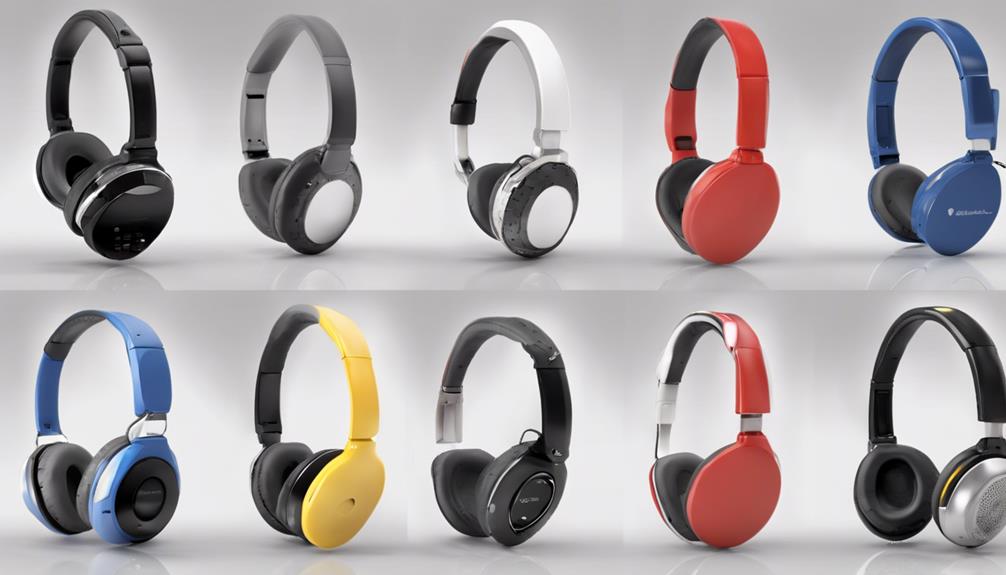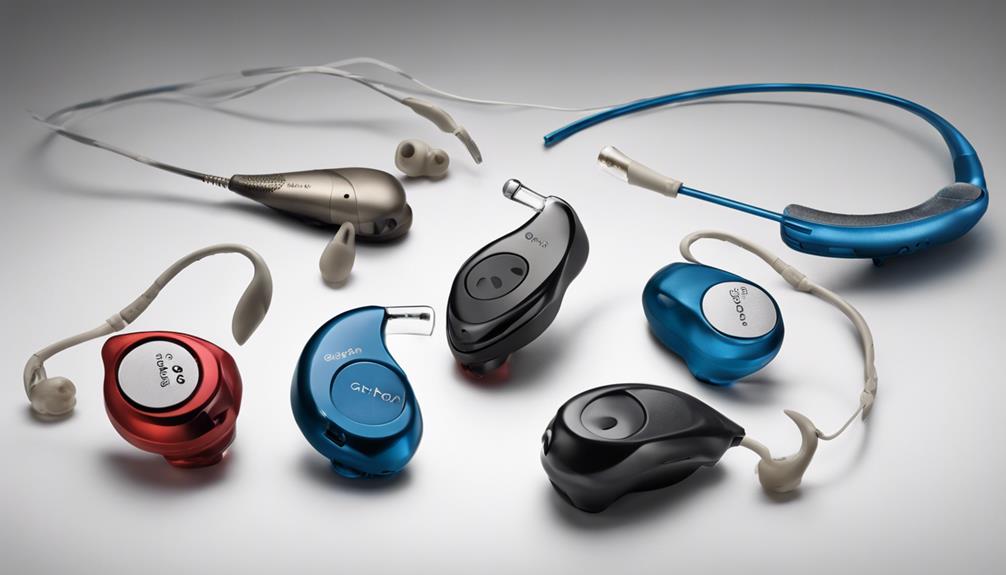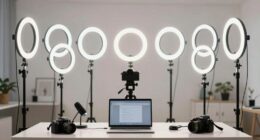Discovering the realm of assistive listening devices has been truly enlightening! We came across revolutionary products designed for individuals with hearing difficulties. Picture tools such as Bluetooth streamers for mobile phones, as well as wireless microphones and TV streamers that revolutionize how sound is experienced in our daily lives. These advancements are paving the way for a new level of connectivity with our environment through audio.
But what sets these top 5 devices apart? Stay tuned to discover how these cutting-edge technologies are reshaping the landscape for individuals with hearing loss.
Key Takeaways
- Personal amplifiers offer portable sound amplification for improved speech clarity and reduced background noise.
- Hearing loop systems use electromagnetic signals to transmit audio, enhancing sound clarity in venues like theaters.
- Bluetooth-enabled devices provide seamless connectivity and high-quality sound transmission for individuals with hearing impairments.
- TV streamers offer crystal-clear audio streaming directly to hearing aids, enhancing the viewing experience for individuals with hearing loss.
Personal Amplifiers
Personal amplifiers offer individuals with hearing impairment a portable solution to amplify sound in various settings, enhancing speech clarity and reducing background noise. These assistive listening devices are ideal for situations like one-on-one conversations, small group settings, or watching TV.
The compact size and ease of use make personal amplifiers convenient for on-the-go use. Some models even come with features like volume and tone control, allowing users to personalize their listening experience based on their needs.
By using personal amplifiers, individuals with hearing impairment can enjoy improved listening experiences without the distraction of surrounding noise. These devices are discreet and can be worn or carried effortlessly, providing a practical solution for those seeking to enhance their ability to hear clearly in everyday situations.
With their focus on speech clarity and portability, personal amplifiers are valuable tools for individuals looking to improve their listening experiences in various environments.
Hearing Loop Systems

Hearing loop systems utilize electromagnetic signals to directly transmit audio to telecoil-equipped hearing aids, enhancing sound clarity by reducing background noise for individuals with hearing loss. These systems are an assistive listening technology commonly found in venues like theaters and churches, recommended by the ADA for their efficacy in improving accessibility.
By leveraging telecoils in hearing aids, hearing loop systems help users focus on the desired audio, minimizing distractions from surrounding noise. One significant advantage of hearing loop systems is their cost-effectiveness compared to other assistive listening devices. They offer a seamless listening experience for individuals with compatible hearing aids, delivering clear sound directly to the user.
The integration of hearing loop systems in various public spaces underscores their importance in creating inclusive environments for those with hearing impairments.
Bluetooth-Enabled Devices
Bluetooth-enabled devices revolutionize assistive listening technology by offering seamless connectivity and high-quality sound transmission for individuals with hearing impairments. These innovative devices provide hands-free communication with up to two mobile phones simultaneously, enhancing convenience for users.
Worn around the neck, they transmit crystal-clear sound directly to compatible hearing aids, ensuring a personalized listening experience. Bluetooth technology enables the customization of settings through mobile apps, allowing for easy control and adjustment according to individual preferences.
Additionally, these devices can be connected to a variety of Bluetooth-enabled devices such as phones and tablets, offering versatile streaming options for users. With a stylish and versatile design, Bluetooth-enabled devices not only improve wireless connectivity but also enhance communication in diverse environments, making them an excellent choice for individuals seeking advanced assistive listening solutions.
TV Streamers

TV streamers, such as the GN ReSound TV Streamer 2, offer crystal-clear audio streaming from your television, enhancing your viewing experience with a remarkable 23 feet range for flexible usage. These devices are designed to transmit high-quality sound directly to hearing aids, making them an ideal solution for individuals with hearing loss.
By providing clear and personalized audio, TV streamers allow users to enjoy TV shows without missing out on important dialogue or audio details. The GN ReSound TV Streamer 2 is known for its ease of setup and seamless integration with existing hearing aid systems, ensuring enhanced audio clarity for the user.
With the help of TV streamers, individuals can immerse themselves in their favorite programs while overcoming the challenges posed by hearing loss, ultimately improving their overall viewing experience.
Wireless Microphones
Utilizing advanced technology, wireless microphones like the Phonak Roger Select significantly enhance auditory performance in challenging environments where background noise can impede communication. These wireless microphones are designed to improve the clarity of speech and boost user participation in conversations, making them essential accessories for individuals with hearing loss.
Here are some key points to consider about wireless microphones for the hearing impaired:
- The Phonak Roger Clip On Mic Microphone 1.1 is a powerful directional microphone that's perfect for social gatherings or watching TV.
- The Phonak Roger NeckLoop Receiver (Type 03) is an excellent option for individuals with hearing aids equipped with Telecoil technology, providing a simple and affordable way to enhance audio streaming.
- Wireless microphones help individuals with hearing loss communicate effectively in various settings, such as restaurants or offices.
- These devices play a crucial role in overcoming the challenges posed by background noise and ensuring clear communication for the user.
- Investing in a high-quality wireless microphone can significantly improve the overall auditory experience for individuals with hearing impairments.
Frequently Asked Questions
What Is the Most Commonly Used Assistive Listening Device?
The most commonly used assistive listening device is the hearing loop system. It uses electromagnetic energy to transmit sound directly to compatible receivers. Telecoils in many hearing aids pick up signals from hearing loops for clearer sound.
Popular in places like churches and theaters, hearing loops are convenient and effective for individuals with hearing loss. Their widespread use makes them a preferred choice for many seeking improved listening experiences.
What Are the 5 Assistive Devices for the Deaf?
When considering assistive devices for the deaf, it's crucial to explore options like:
- Hearing loops
- FM systems
- Infrared systems
- Alerting devices
- Wireless or Bluetooth-enabled hearing aids
These tools serve to amplify sounds, enhance clarity, and facilitate communication in various environments. Each device offers unique benefits, such as direct sound transmission with hearing loops and improved speech discrimination in noisy settings with FM systems. Alerting devices, on the other hand, provide visual or auditory cues for events like alarms or phone calls.
What Assistive Devices Are Available for Patients Who Have Decreased Hearing?
When addressing patients with decreased hearing, a range of assistive devices can be employed to enhance sound quality, speech discrimination, and overall communication. These tools include hearing aids, FM systems, infrared systems, alerting devices, and Bluetooth-capable devices.
What Hearing Aid Is Good for Hearing Loss in One Ear?
When dealing with hearing loss in one ear, CROS and BiCROS hearing aids are suitable options.
CROS aids transfer sounds from the impaired ear to the better one, enhancing overall hearing.
BiCROS devices amplify sounds from the impaired ear and wirelessly transmit them to the better ear, improving hearing in noisy settings.
Both options help individuals with unilateral hearing loss by providing a more balanced auditory experience.
Conclusion
In conclusion, the top 5 assistive listening devices for the hearing impaired near me offer a range of features to improve communication and enhance daily life.
With options like personal amplifiers, hearing loop systems, and Bluetooth-enabled devices, individuals with hearing loss can stay connected and engaged.
These devices serve as a lifeline for those in need, acting as a bridge to the world of sound.
Embrace the power of technology to amplify your world.











